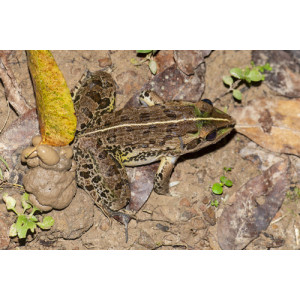@chaten

Boreal Floating Frog Did you see this animal?
Scientific Name : Ingerana borealis
Family : Dicroglossidae
Order : Anura
Class : Amphibia
Phylum : Chordata
Other Name : Boreal Floating Frog, Northern Frog, Rotung Oriental Frog
Habitat : Nocturnal/Forests
Description : The Boreal Floating Frog, also known as the Siberian Floating Frog. They are small in size, usually measuring around 2-3 inches in length, and are known for their ability to float on the surface of water.
The skin of the Boreal Floating Frog is smooth and shiny, and can vary in color from brown to green or gray. Their bodies are flattened and elongated, with long hind legs that are adapted for swimming and jumping. They also have large webbed feet that help them to stay afloat in the water.
When threatened, they play dead by floating belly-up on the surface of the water. This makes them appear unappetizing to predators.
Boreal Floating Frogs have a unique breeding strategy. Females lay their eggs on the surface of the water, and then wrap them in a gelatinous coating that protects them from predators and dehydration. The males will then fertilize the eggs and guard them until they hatch.
Unlike other species of frogs, Boreal Floating Frogs do not have vocal sacs, so they are not able to produce loud croaking calls. Instead, they communicate through a series of soft chirps and clicks.
These frogs are found in a variety of wetland habitats, including swamps, marshes, and ponds. They are primarily active at night, when they hunt for insects and other small prey. During the winter months, Boreal Floating Frogs hibernate in the mud at the bottom of ponds and other bodies of water.
Boreal Floating Frogs are important members of their ecosystems, playing a role in controlling insect populations and serving as prey for larger predators. However, they are also threatened by habitat loss and pollution.
Overall, the Boreal Floating Frog is a unique and fascinating species that has adapted to life in wetland habitats. As with all wildlife, it is important to appreciate and protect these creatures to ensure their survival for future generations.
The skin of the Boreal Floating Frog is smooth and shiny, and can vary in color from brown to green or gray. Their bodies are flattened and elongated, with long hind legs that are adapted for swimming and jumping. They also have large webbed feet that help them to stay afloat in the water.
When threatened, they play dead by floating belly-up on the surface of the water. This makes them appear unappetizing to predators.
Boreal Floating Frogs have a unique breeding strategy. Females lay their eggs on the surface of the water, and then wrap them in a gelatinous coating that protects them from predators and dehydration. The males will then fertilize the eggs and guard them until they hatch.
Unlike other species of frogs, Boreal Floating Frogs do not have vocal sacs, so they are not able to produce loud croaking calls. Instead, they communicate through a series of soft chirps and clicks.
These frogs are found in a variety of wetland habitats, including swamps, marshes, and ponds. They are primarily active at night, when they hunt for insects and other small prey. During the winter months, Boreal Floating Frogs hibernate in the mud at the bottom of ponds and other bodies of water.
Boreal Floating Frogs are important members of their ecosystems, playing a role in controlling insect populations and serving as prey for larger predators. However, they are also threatened by habitat loss and pollution.
Overall, the Boreal Floating Frog is a unique and fascinating species that has adapted to life in wetland habitats. As with all wildlife, it is important to appreciate and protect these creatures to ensure their survival for future generations.
Distribution in Bangladesh
References:
description written by: Md. Shalauddin, Department of Zoology, Jagannath University, Dhaka. Information sources: IUCN Red List Bangladesh-2015, Hasan 2014, Khan 2018 (Photographic guide to the wildlife of Bangladesh).photo credit:chaten(www.inaturalist.org/people/chaten),photo copyright: iNaturalist. more information please contact with us.
description written by: Md. Shalauddin, Department of Zoology, Jagannath University, Dhaka. Information sources: IUCN Red List Bangladesh-2015, Hasan 2014, Khan 2018 (Photographic guide to the wildlife of Bangladesh).photo credit:chaten(www.inaturalist.org/people/chaten),photo copyright: iNaturalist. more information please contact with us.




















